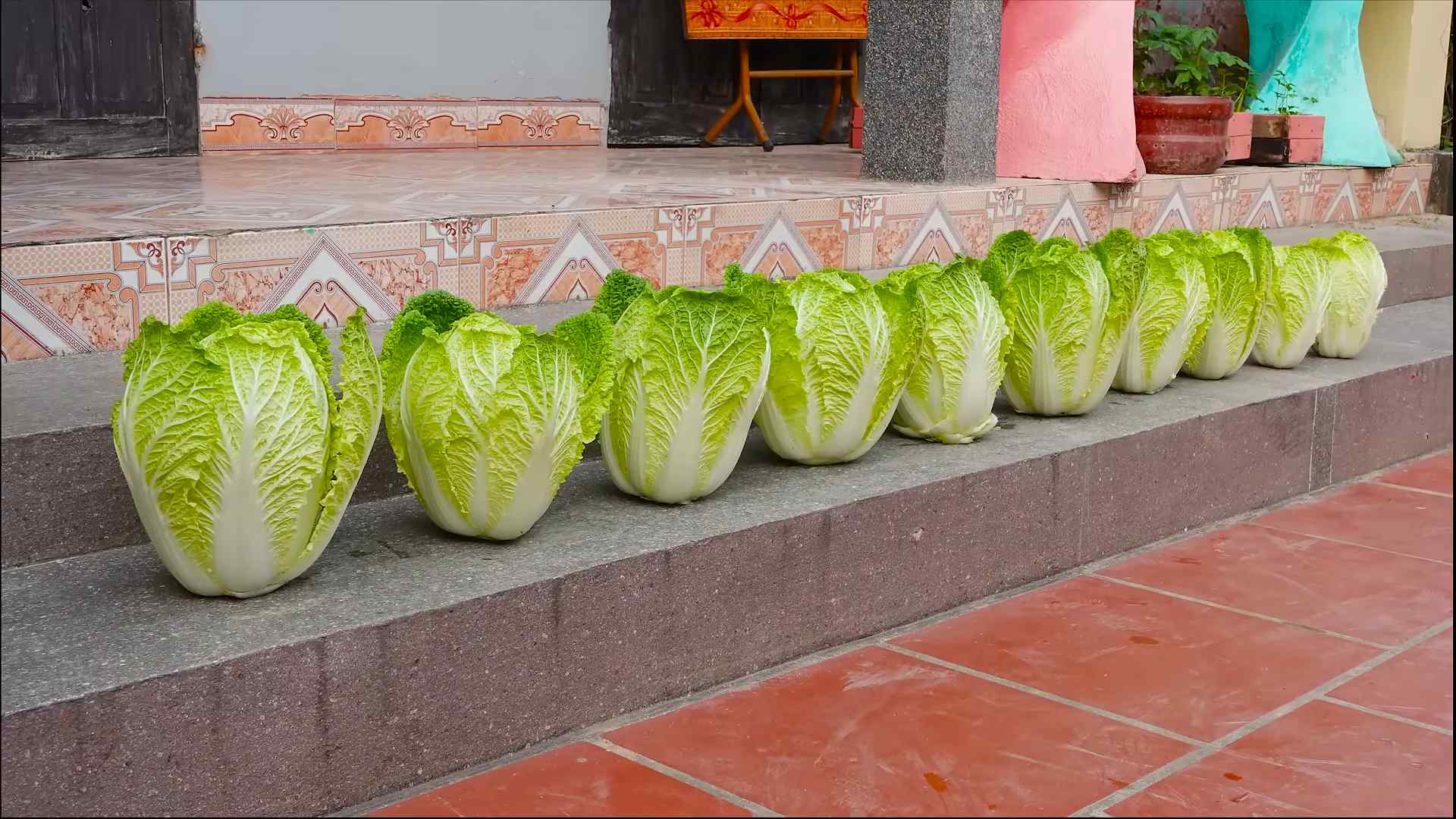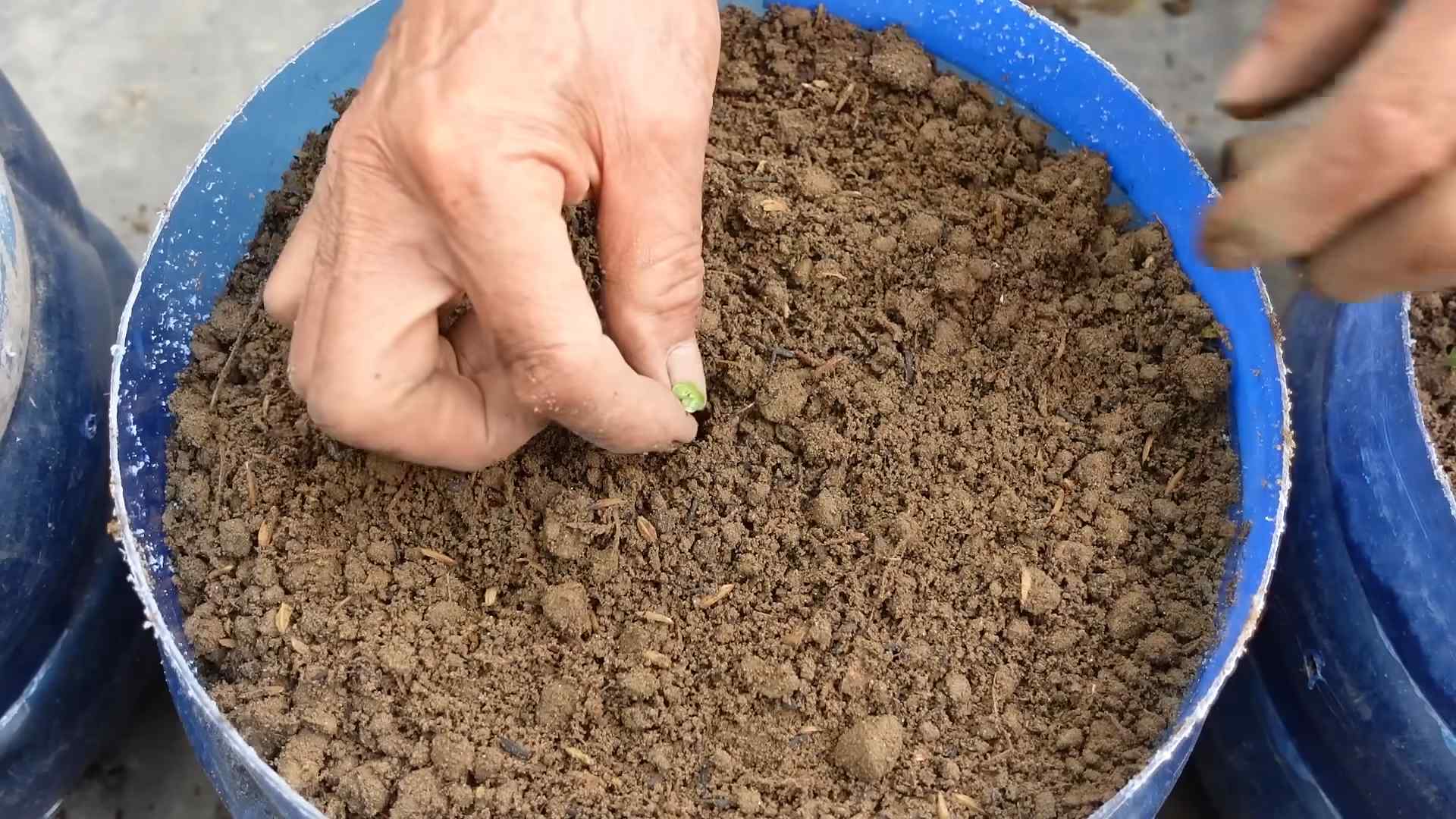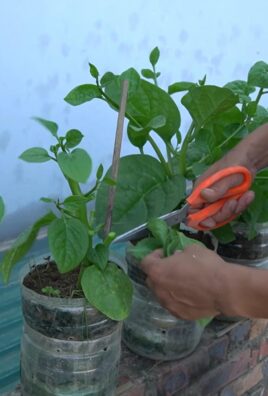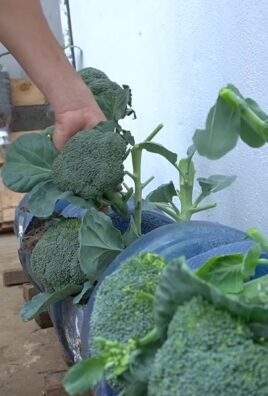Growing Napa Cabbage in Small Spaces might seem like a challenge, but trust me, it’s totally achievable! Have you ever dreamed of harvesting your own crisp, delicious Napa cabbage right from your balcony or patio? I know I have! For centuries, Napa cabbage, a staple in Asian cuisine, has been cultivated for its mild flavor and versatility. From kimchi to stir-fries, it’s a culinary powerhouse. But what if you don’t have a sprawling garden? That’s where these clever DIY tricks come in.
Many people are intimidated by the thought of growing vegetables, especially in limited areas. They think it requires acres of land and years of experience. But the truth is, with a few simple hacks, you can enjoy fresh, homegrown Napa cabbage, even if you’re living in a tiny apartment. This article is packed with easy-to-follow instructions and tips that will empower you to successfully cultivate this amazing vegetable, regardless of your space constraints. I’m going to show you how to maximize your yield, choose the right containers, and avoid common pitfalls. So, let’s dive in and discover the secrets to growing Napa Cabbage in Small Spaces and bring a taste of the garden to your table!

Growing Napa Cabbage in Small Spaces: A DIY Guide
Hey there, fellow gardening enthusiasts! So, you’re dreaming of fresh, crunchy Napa cabbage but are short on space? Don’t worry, I’ve got you covered! Growing Napa cabbage in small spaces is totally achievable with a little planning and some clever techniques. I’m going to walk you through everything I’ve learned, from choosing the right container to harvesting your delicious homegrown cabbage. Let’s get started!
Choosing the Right Container and Soil
First things first, let’s talk about where your Napa cabbage will call home. The right container and soil are crucial for success, especially when space is limited.
* Container Size: Napa cabbage needs room to spread its roots. I recommend a container that’s at least 12 inches in diameter and 12 inches deep. A 5-gallon bucket or a large planter works perfectly.
* Material: Plastic, terracotta, or even fabric grow bags are all good options. Fabric grow bags are great because they allow for better drainage and aeration, which can prevent root rot.
* Drainage: This is non-negotiable! Make sure your container has drainage holes. Napa cabbage doesn’t like soggy feet.
* Soil: Use a well-draining, nutrient-rich potting mix. I like to mix equal parts of compost, peat moss (or coco coir), and perlite. This combination provides good drainage, aeration, and plenty of nutrients.
Starting Your Napa Cabbage
You can start Napa cabbage from seeds or transplants. I personally prefer starting from seeds because it gives me more control over the entire process.
* Starting from Seeds:
* Timing: Napa cabbage is a cool-season crop, so you’ll want to start your seeds indoors about 4-6 weeks before the last expected frost in spring or about 8-10 weeks before the first expected frost in fall.
* Sowing: Fill seed trays or small pots with your potting mix. Sow the seeds about ¼ inch deep.
* Watering: Gently water the soil and keep it consistently moist but not soggy.
* Light: Place the seed trays under grow lights or in a sunny window. Napa cabbage seedlings need plenty of light.
* Thinning: Once the seedlings have a few true leaves, thin them out, leaving only the strongest seedling in each pot.
* Using Transplants:
* Choosing Transplants: Select healthy-looking transplants with sturdy stems and no signs of disease or pests.
* Hardening Off: Before planting your transplants outdoors, you’ll need to harden them off. This means gradually exposing them to outdoor conditions over a period of about a week. Start by placing them in a sheltered spot for a few hours each day, gradually increasing the amount of time they spend outdoors.
Planting Your Napa Cabbage
Now for the fun part – planting your Napa cabbage in its container!
1. Prepare the Container: Fill your chosen container with your well-draining potting mix, leaving a few inches of space at the top.
2. Planting Seedlings: If you started from seeds, gently remove the seedlings from their pots and plant them in the container. If you’re using transplants, carefully remove them from their containers.
3. Spacing: Space the plants about 12 inches apart. If you’re only growing one plant per container, plant it in the center.
4. Planting Depth: Plant the seedlings or transplants at the same depth they were growing in their original containers.
5. Watering: Water thoroughly after planting.
Caring for Your Napa Cabbage
Napa cabbage needs consistent care to thrive, especially in containers. Here’s what you need to know:
* Watering: Napa cabbage needs consistent moisture, especially during hot weather. Water deeply whenever the top inch of soil feels dry to the touch. Avoid overwatering, as this can lead to root rot.
* Fertilizing: Feed your Napa cabbage every 2-3 weeks with a balanced liquid fertilizer. I like to use a fertilizer that’s specifically formulated for vegetables.
* Sunlight: Napa cabbage needs at least 6 hours of sunlight per day. Place your container in a sunny location.
* Pest Control: Keep an eye out for pests like aphids, cabbage worms, and slugs. Handpick pests whenever possible. You can also use organic pest control methods like insecticidal soap or neem oil.
* Weed Control: Keep the container free of weeds. Weeds can compete with your Napa cabbage for nutrients and water.
* Mulching: Add a layer of mulch around the base of the plant to help retain moisture, suppress weeds, and regulate soil temperature. Straw, wood chips, or shredded leaves work well.
Protecting Your Napa Cabbage
Napa cabbage is susceptible to certain environmental challenges. Here’s how to protect your plants:
* Bolting: Napa cabbage can bolt (go to seed) if exposed to hot weather. To prevent bolting, try to plant your Napa cabbage in a location that gets some afternoon shade. You can also use shade cloth to protect the plants from the sun.
* Frost Protection: If you’re growing Napa cabbage in the fall, be prepared to protect it from frost. You can cover the plants with blankets or row covers when frost is predicted.
* Wind Protection: Strong winds can damage Napa cabbage plants. If you live in a windy area, consider placing your container in a sheltered location.
Harvesting Your Napa Cabbage
The moment you’ve been waiting for! Harvesting your homegrown Napa cabbage is incredibly rewarding.
1. Timing: Napa cabbage is typically ready to harvest about 70-80 days after planting. The head should be firm and compact.
2. Harvesting: Use a sharp knife to cut the head of the cabbage from the base of the plant.
3. Storage: Store your Napa cabbage in the refrigerator. It will keep for several weeks.
Troubleshooting Common Problems
Even with the best care, you might encounter some problems while growing Napa cabbage. Here are some common issues and how to address them:
* Yellowing Leaves: This could be a sign of nutrient deficiency. Try fertilizing your plants with a balanced liquid fertilizer.
* Stunted Growth: This could be caused by a variety of factors, including poor soil, lack of sunlight, or pest infestation. Make sure your plants are getting enough sunlight, water, and nutrients. Check for pests and treat them accordingly.
* Root Rot: This is caused by overwatering. Make sure your container has good drainage and avoid overwatering.
* Pest Infestation: Keep an eye out for pests like aphids, cabbage worms, and slugs. Handpick pests whenever possible. You can also use organic pest control methods like insecticidal soap or neem oil.
Maximizing Space with Companion Planting
Companion planting is a great way to maximize space and improve the health of your Napa cabbage. Here are some good companion plants:
* Marigolds: These repel nematodes and other pests.
* Dill: This attracts beneficial insects that prey on aphids and other pests.
* Chamomile: This attracts beneficial insects and can improve the flavor of your Napa cabbage.
* Radishes: These can help to deter flea beetles.
* Onions and Garlic: These can help to repel pests.
Creative Container Ideas for Small Spaces
If you’re really short on space, get creative with your container choices! Here are a few ideas:
* Hanging Baskets: While Napa cabbage gets quite large, you could try growing smaller varieties in hanging baskets.
* Vertical Gardens: Use a vertical garden to grow Napa cabbage alongside other herbs and vegetables.
* Repurposed Containers: Old buckets, tires, or even dresser drawers can be repurposed into containers for growing Napa cabbage. Just make sure they have drainage holes!
Choosing the Right Napa Cabbage Variety
While most Napa cabbage varieties will do well in containers, some are better suited for small spaces than others. Look for varieties that are compact or early-maturing. Here are a few to consider:
* Blues: This is a compact variety that matures quickly.
* Optiko: This is another early-maturing variety that’s well-suited for small spaces.
* Minuet: This is a smaller variety that’s perfect for containers.
Enjoying Your Homegrown Napa Cabbage
Now that you’ve successfully grown your own Napa cabbage, it’s time to enjoy the fruits (or rather, vegetables) of your labor! Napa cabbage is incredibly versatile and can be used in a variety of dishes. Here are a few ideas:
* Salads: Napa cabbage is a great addition to salads. Its mild flavor and crunchy texture make it a perfect complement to other vegetables.
* Slaws:

Conclusion
So, there you have it! Growing Napa cabbage in small spaces isn’t just a pipe dream; it’s a delicious reality waiting to happen. We’ve walked through the essentials, from selecting the right variety to optimizing your limited area for maximum yield. But why should you actually *do* this?
Because fresh, homegrown Napa cabbage is simply superior. The crispness, the subtle sweetness, the satisfaction of knowing you nurtured it from seed to harvest – it’s an experience you can’t replicate with store-bought produce. Plus, think of the money you’ll save, and the reduced carbon footprint from not relying on long-distance transportation.
This DIY trick is a must-try for anyone who values fresh, healthy food and enjoys the rewarding process of gardening, even if you only have a balcony, patio, or small yard. It’s about reclaiming control over your food source and connecting with nature in a meaningful way.
But don’t stop there! Experiment with different varieties of Napa cabbage. Try the ‘Blues’ variety for its disease resistance, or ‘Optiko’ for its compact size. Consider companion planting with herbs like dill or chamomile to deter pests naturally. You can also adjust the soil mix to suit your specific climate and growing conditions. Perhaps you’ll discover a new favorite method or a unique flavor profile.
And remember, success in gardening is often about learning from your mistakes. Don’t be discouraged if your first attempt isn’t perfect. Every season is a new opportunity to refine your technique and improve your results.
We wholeheartedly encourage you to give this DIY trick a try. Embrace the challenge, get your hands dirty, and experience the joy of harvesting your own delicious Napa cabbage. And most importantly, share your journey with us! We’d love to hear about your successes, your challenges, and any tips or variations you discover along the way. Post pictures of your thriving Napa cabbage plants, share your favorite recipes, and let’s build a community of small-space Napa cabbage enthusiasts! Your experiences can inspire others and help us all become better gardeners. Let’s cultivate a greener, healthier, and more delicious world, one Napa cabbage at a time.
Frequently Asked Questions (FAQs)
Q: What is the best time of year to start growing Napa cabbage in a small space?
A: Napa cabbage is a cool-season crop, so the best time to start growing it is in the spring or fall. For a spring harvest, start seeds indoors about 4-6 weeks before the last expected frost. For a fall harvest, sow seeds directly into the garden or containers in late summer, about 6-8 weeks before the first expected frost. Pay attention to your local climate and adjust planting times accordingly. If you live in an area with mild winters, you may even be able to grow Napa cabbage throughout the winter months.
Q: How much sunlight does Napa cabbage need when grown in containers?
A: Napa cabbage needs at least 6 hours of direct sunlight per day to thrive. If you’re growing it in containers, make sure to place them in a sunny location. If you don’t have a spot that gets full sun, you can supplement with grow lights. Rotate the containers regularly to ensure that all sides of the plants receive adequate sunlight. Insufficient sunlight can lead to leggy growth and reduced head formation.
Q: What type of soil is best for growing Napa cabbage in containers?
A: Napa cabbage prefers well-draining, fertile soil with a pH between 6.0 and 7.5. A good potting mix for containers should consist of a blend of compost, peat moss or coco coir, and perlite or vermiculite. The compost provides nutrients, the peat moss or coco coir helps retain moisture, and the perlite or vermiculite improves drainage. You can also add a slow-release fertilizer to the soil mix to provide a steady supply of nutrients throughout the growing season. Avoid using garden soil in containers, as it can become compacted and poorly drained.
Q: How often should I water Napa cabbage grown in containers?
A: Napa cabbage needs consistent moisture to grow well, especially when grown in containers. Water deeply whenever the top inch of soil feels dry to the touch. Avoid overwatering, as this can lead to root rot. During hot, dry weather, you may need to water more frequently. Mulching around the base of the plants can help retain moisture in the soil. Check the drainage holes in your containers to ensure that excess water can escape.
Q: What are some common pests and diseases that affect Napa cabbage, and how can I control them?
A: Common pests that affect Napa cabbage include aphids, cabbage worms, flea beetles, and slugs. Diseases include clubroot, black rot, and downy mildew. To control pests, you can use insecticidal soap, neem oil, or Bacillus thuringiensis (Bt). Row covers can also help protect plants from pests. To prevent diseases, choose disease-resistant varieties, practice crop rotation, and ensure good air circulation. Remove any infected leaves or plants promptly. Proper watering and fertilization can also help strengthen plants and make them less susceptible to diseases.
Q: How do I know when my Napa cabbage is ready to harvest?
A: Napa cabbage is typically ready to harvest when the head is firm and compact. The exact size and shape of the head will vary depending on the variety. Gently squeeze the head to check for firmness. If it feels solid, it’s likely ready to harvest. You can also check the maturity date on the seed packet or plant tag as a general guideline. To harvest, cut the head off at the base with a sharp knife.
Q: Can I grow Napa cabbage in a hydroponic system in a small space?
A: Yes, growing Napa cabbage hydroponically is definitely possible, especially in small spaces. Hydroponics allows you to control the nutrient supply and environmental conditions, which can lead to faster growth and higher yields. You can use various hydroponic systems, such as deep water culture (DWC), nutrient film technique (NFT), or a simple Kratky method. Make sure to provide adequate lighting and monitor the pH and nutrient levels of the hydroponic solution. Hydroponics can be a great option for growing Napa cabbage indoors or in limited outdoor spaces.
Q: What are some good companion plants for Napa cabbage?
A: Companion planting can help deter pests, attract beneficial insects, and improve the overall health of your Napa cabbage plants. Good companion plants for Napa cabbage include:
* **Aromatic herbs:** Dill, chamomile, rosemary, and thyme can help repel pests.
* **Marigolds:** These flowers attract beneficial insects and deter nematodes.
* **Nasturtiums:** These flowers attract aphids away from your Napa cabbage.
* **Garlic and onions:** These plants can help deter pests and prevent fungal diseases.
* **Clovers:** Can help fix nitrogen in the soil.
Avoid planting Napa cabbage near other members of the brassica family (e.g., broccoli, cauliflower, kale), as they can attract the same pests and diseases.
Q: Can I grow Napa cabbage indoors if I don’t have a garden or balcony?
A: Yes, you can grow Napa cabbage indoors, but it requires providing the right conditions. You’ll need a sunny window that receives at least 6 hours of direct sunlight per day, or you’ll need to supplement with grow lights. Choose a compact variety of Napa cabbage that is well-suited for container growing. Use a well-draining potting mix and water regularly. Monitor for pests and diseases and take action promptly if any problems arise. Growing Napa cabbage indoors can be a rewarding experience, especially if you live in an apartment or have limited outdoor space.
Q: How can I prevent my Napa cabbage from bolting (going to seed)?
A: Bolting occurs when Napa cabbage is exposed to prolonged periods of warm weather or stress. To prevent bolting, choose bolt-resistant varieties, plant at the appropriate time of year (spring or fall), and provide consistent moisture. Mulching around the base of the plants can help keep the soil cool. If you experience a sudden heat wave, provide shade for your plants. Harvest your Napa cabbage as soon as it is mature to prevent it from bolting.





Leave a Comment